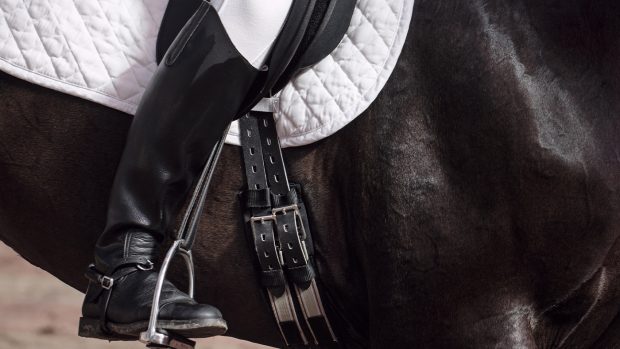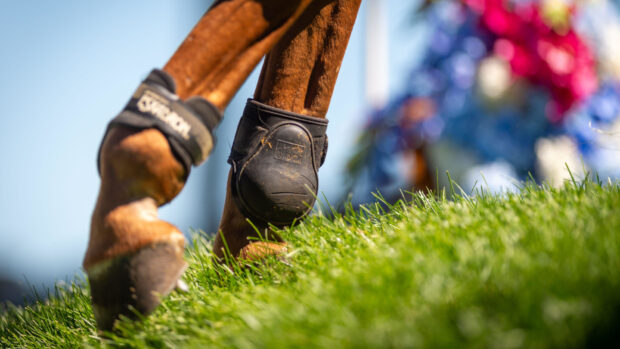As knowledge of the horse’s anatomy increases, so does the proliferation of anatomical bridles and types of noseband. Like all pieces of tack, finding the right noseband to suit your horse can be the difference between a happy partnership and an unhappy horse and rider. With such a wide range of choices on the market, you should be able to find the perfect noseband for your needs.
If you are currently having problems getting your horse to accept the contact or are lacking control, there are some important questions to ask yourself before a different type of noseband:
- Is your horse uncomfortable because of dental problems?
- Are resistances in his mouth a sign that he is uncomfortable somewhere else or finds the work too difficult for his stage of training?
- Are your rein aids too strong?
Remember that a horse’s mouth and jaw need to be soft and relaxed for him to accept the bit. If you strap his mouth shut with a tight noseband, you could cause more problems. Nosebands should never be fastened too tightly as this can jeopardise horse welfare. As a guide, you should be able to fit at least two fingers between the noseband and the face.
In theory, nosebands that fasten below the bit should only be used with a snaffle bit to avoid conflict between the bottom strap and a curb chain. In practice, many riders use flash or grakle nosebands with pelhams or kimblewicks, especially for showjumping and cross-country.
Nosebands are usually sold in pony, cob and full sizes. As with all bridle parts, when buying a noseband take the dimensions of your horse’s head into account. For example, a thoroughbred with a narrow muzzle may need a cob size while a stocky mountain and moorland may take a cob or full size.
If you compete in dressage or eventing, check your rulebook, as not all types of noseband are permitted.
Common types of noseband for horses

The cavesson noseband
The cavesson is the simplest noseband and gives a smart appearance. It can also be used for attaching a standing martingale to, if you need to use one.
Action: the action of a cavesson noseband is very slight, unless it is used with a standing martingale. This, or the crank noseband, is the only sort which should be used with a double bridle.
Fitting: to make sure the cavesson is fitted correctly, you should be able to place two fingers between the horse’s protruding cheek bone and the body of the noseband. You should be able to comfortably slide at least one finger between the noseband and your horse’s face all the way round.

The flash noseband
The flash noseband was originally invented so that a standing martingale could be attached to the top (cavesson) part, while the bottom strap fastens below the bit to prevent the horse from opening its mouth wide to evade the bit.
Action: helps prevent a horse opening his mouth too wide, but is not as definite in its action as some designs. Some horses accept it better for this reason. It also helps keep a jointed loose ring snaffle central in the mouth. Beware flashes with narrow cavessons, as they tend to slide down the nose.
Fitting: adjust the top part so you can slide a finger all round and the bottom strap to fit two fingers between it and the horse’s nose.

The crank noseband
The crank noseband, which is also called a cinchback or doubleback, is designed to be fastened snugly around the horse’s nose, without a buckle to dig into the back of the horse’s jaw. This style of noseband can be used with any type of bit.
Action: helps prevent a horse from opening/crossing his jaw when you can’t use a noseband which fastens below the bit and is popular with dressage riders who use double bridles. Some people don’t like it because some riders over-tighten it to prevent the horse from opening the mouth at all. Can cause calluses if it is repeatedly fastened too tight.
Fitting: similar to the cavesson, but fitted more snugly. It shouldn’t touch the protruding cheek bones, nor should the skin be pinched when the contact on the bit is taken up by the rider.
A rope noseband is stronger than traditional leather, and can be used to give more control on a strong horse than a regular cavesson or as an alternative to the crank. They are also available with flash attachment.

The drop noseband
Traditionally these nosebands adjusted at the front and the back, but most now fasten only at the back.
Action: prevents a horse opening his mouth to resist the contact, but has a more definite action than the flash. Some horses respond well but others resent it. The low pressure point in front and pressure in the curb groove at the back is said by some to encourage a horse to lower his head.
Fitting: if fitted too low, it can interfere with a horse’s breathing so make sure it’s at least six centimetres above the nostrils on the solid part of the horse’s nose and you can slide a finger all the way round. Never fasten a standing martingale to a drop.
There are new designs that aim to combine the effects of the cavesson with a drop noseband, such Dy’on’s double noseband. This controls the shifting of the jaw, limits the mouth opening and is designed for strong horses.

The grackle noseband
The grackle noseband is named after the hard-pulling winner of the 1931 Grand National and is particularly popular with event riders for the cross-country phase. It’s sometimes called a figure of eight or crossover noseband because of its shape. It is also a common choice for racehorses – it can help the horse relax, settle and therefore breathe better.
Action: designed to prevent a horse opening his mouth and crossing his jaw, the front crossover point of the grackle is the main pressure point. The straps pass through a slotted leather circle, which usually has a sheepskin backing.
Fitting: the leather circle should be on the centre front of the nose, with the top straps just below the facial bones to avoid rubbing. Allow at least a finger’s width between top and bottom straps and the horse’s jaw.
A later version of this noseband, usually called the American, Mexican or high-ring grackle, has a top strap which starts higher up the face. It has a “softer” action and some horses prefer it.
You can also buy an elastic grackle, which provides the action of the grackle but without the restriction of the leather that some horses fight against.
Other types of noseband: for strong horses
Sheepskin, Australian cheeker, Worcester, Kineton and combination nosebands are designed to give extra control for particular problems.
A sheepskin noseband is a simple sheepskin sleeve that fits over a cavesson or the cavesson part of a flash and is designed to persuade a horse who holds his head too high to carry it lower, because when he raises his head, he cannot see over the fluffy sheepskin.

The Australian cheeker is two rubber bit rings connected by a central rubber strap which fastens to the bridle headpiece. It is commonly used in racing. It’s said to persuade pullers to “back off” from the sight of the central strap and to have a psychological rather than physical effect. It also helps to keep the bit high enough in the mouth to prevent the horse putting his tongue over it.

The Kineton, or Puckle, noseband applies strong nose pressure via two U-shaped metal loops which pass behind the bit rings, so rein pressure is transferred to the nose. This has a severe action.
The combination or lever noseband has a half-moon piece of metal that goes on each side of the horse’s face. A piece of leather attaches to the top end of the metal curve (near the horse’s cheek bone), which runs under the jaw and attaches to the other side of the face. In the middle of the metal curve, a piece of leather runs over the top of the nose, acting as the main noseband, but it sits slightly lower than a standard cavesson — somewhere between a cavesson and a drop noseband. A third piece of leather runs from the bottom of the metal curve under the chin groove of the horse. This noseband is similar in design to the grackle, and works by preventing the horse from crossing his jaw, which gives the rider more control.

You may also be interested to read…

8 bridles with flash nosebands that you might like in your tack room

13 anatomical bridles to ensure maximum comfort

Grackle bridles for every budget

Study questions tight noseband ethics after bone damage found
Researchers asked two independent vets to look a sample of 144 mature warmblood cavalry horses

Subscribe to Horse & Hound magazine today – and enjoy unlimited website access all year round
Horse & Hound magazine, out every Thursday, is packed with all the latest news and reports, as well as interviews, specials, nostalgia, vet and training advice. Find how you can enjoy the magazine delivered to your door every week, plus options to upgrade your subscription to access our online service that brings you breaking news and reports as well as other benefits.




